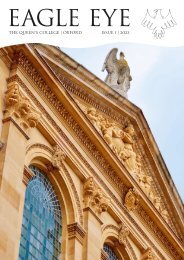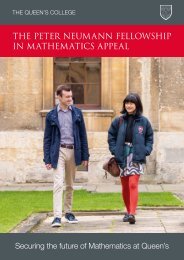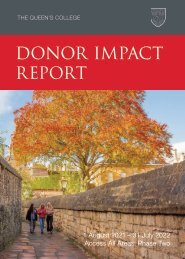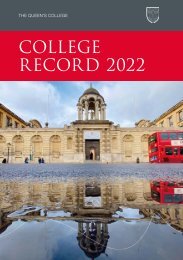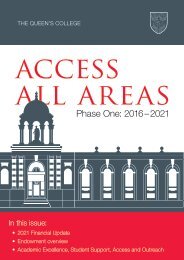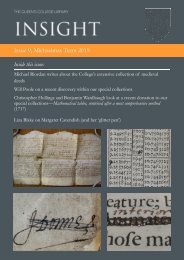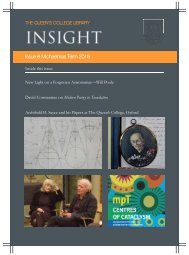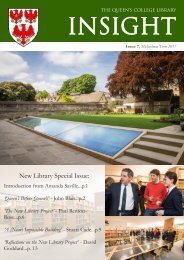The Queen's College Record 2023
You also want an ePaper? Increase the reach of your titles
YUMPU automatically turns print PDFs into web optimized ePapers that Google loves.
Old Members’ Activities<br />
<strong>The</strong> next day, we left the hostel early again, and continued on to Yunomine, a hot<br />
spring town close to the first Taisha. As we spent most of the day walking, we waited<br />
until the next day to finish the journey from Yunomine to the Kumano Hongu Taisha.<br />
Due to the hotsprings, water came out of the ground hot enough to boil eggs, so we<br />
ate our special onsen eggs with instant ramen for our dinner that day. From there,<br />
the next day we hiked to Kumano Hongu Taisha, and then on to our next hostel,<br />
where we spent one day letting ourselves recover from the hiking (and as it was my<br />
20th birthday, I wanted some time to call my family in the UK). This hostel was also<br />
located close to a river, and so we joined the locals by swimming in the river in the<br />
golden twilight.<br />
On the 13th, we set off on a bus to the Hayatama Taisha, and then a bus to the<br />
bottom of the mountain beneath Nachi Taisha, in order to complete the shrines<br />
in order. Hayatama was very quiet, despite being in a large city, compared to the<br />
Nachi Taisha, which due to its famous large waterfall had many more people there.<br />
We took a tourist bus from Shingu bus station, close to where the Hayatama Shrine<br />
was, to the Nachi shrine. However, as Japan was not allowing foreign tourists into<br />
the country due to the Covid-19 pandemic, every shrine was pretty empty of people.<br />
<strong>The</strong>n, as I was catching a ferry from Nagoya on the 14th of August, and my friend<br />
had to return to Tokyo for her job, we took a five hour coach from the nearest city<br />
from Nachi Taisha, to the city of Nagoya.<br />
I was also able to complete Goshuin for each of the shrines. Traditionally, when people<br />
would go to temples to complete sutras, they would receive a ‘Goshuin’ mark as a<br />
completion token, and now many people collect these when they visit both shrines and<br />
temples. I started collecting Goshuin during my pilgrimage, but, in my later journeys<br />
around Japan, I continued to collect Goshuin from other places as well. It’s also<br />
traditional to buy good luck charms at shrines, and so I bought a wooden one in the<br />
shape of a three-legged crow, which is the symbol that represents the Kumano Kodo<br />
pilgrimage. It is written in the Kojiki, legends that describe the creation of Japan, a<br />
three-legged crow, or Yatagarasu, was sent by the gods to lead the first emperor of<br />
Japan to the place where he should found his capital city. Since then, the three-legged<br />
crow has been associated with finding one’s way, which I thought was an appropriate<br />
good luck charm to buy before I embarked on the following few weeks of solo travel.<br />
Altogether, this trip cost about 75,000 JPY, which is about £450. Most of this went<br />
towards the accommodation, as most people do not hike the route anymore, places<br />
to stay between the first major shrine, and the place I set off from were expensive or<br />
difficult to find. Overall, the accommodation costs worked out to about £80 a night,<br />
and the rest of the budget was spent on food, bus fares and purchasing shrine goods<br />
such as protection charms, goshuin etc.<br />
I experienced many positive things because of this trip. First of all, a deeper<br />
connection and respect for nature through hiking the mountain trails for long<br />
76 <strong>The</strong> Queen’s <strong>College</strong> | <strong>College</strong> <strong>Record</strong> <strong>2023</strong>








